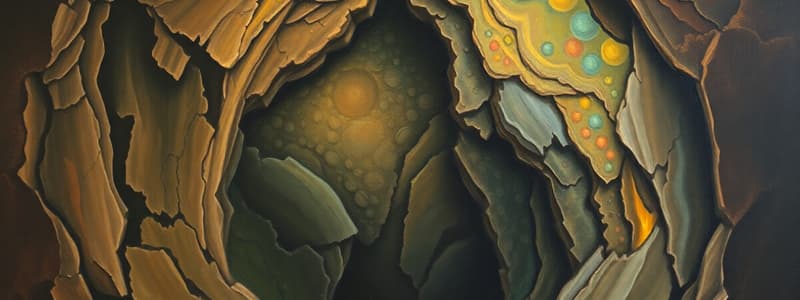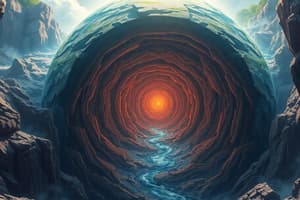Podcast
Questions and Answers
What is the outcome of a subduction event at convergent plate boundaries?
What is the outcome of a subduction event at convergent plate boundaries?
- Formation of deep ocean trenches (correct)
- Development of new continental crust
- Creation of rift valleys
- Increase in seismic activity in the region
What features are generated as a result of colliding oceanic and continental plates?
What features are generated as a result of colliding oceanic and continental plates?
- Volcanic island arcs and deep ocean trenches (correct)
- Plateaus and expanded inland seas
- Mountain ranges and ocean basins
- Radiating fault systems and fracture zones
What geological process occurs as a result of crust melting and magma generation at convergent plate boundaries?
What geological process occurs as a result of crust melting and magma generation at convergent plate boundaries?
- Formation of sedimentary rock layers
- Volcanism and the creation of new landforms (correct)
- Increased weathering of surface materials
- Erosion of continental platforms
Which of the following would NOT be a result of a collision between two continental plates?
Which of the following would NOT be a result of a collision between two continental plates?
How does palaeomagnetism contribute to our understanding of plate tectonics?
How does palaeomagnetism contribute to our understanding of plate tectonics?
What is the term used to describe the interactions between life and the atmosphere, hydrosphere, and solid earth?
What is the term used to describe the interactions between life and the atmosphere, hydrosphere, and solid earth?
Which of the following best describes the biosphere?
Which of the following best describes the biosphere?
How does life in the biosphere interact with the hydrosphere?
How does life in the biosphere interact with the hydrosphere?
Which of the following components is part of the biosphere?
Which of the following components is part of the biosphere?
What role does the biosphere play in ecological interactions?
What role does the biosphere play in ecological interactions?
Which of the following statements about the biosphere is false?
Which of the following statements about the biosphere is false?
Which spheres are involved in the ecological interactions defined by the biosphere?
Which spheres are involved in the ecological interactions defined by the biosphere?
What is a characteristic feature of life within the biosphere?
What is a characteristic feature of life within the biosphere?
Which of the following areas is considered a common zone for tectonic earthquakes?
Which of the following areas is considered a common zone for tectonic earthquakes?
What is the average thickness of the Earth's crust?
What is the average thickness of the Earth's crust?
What is the average density of the sial layer?
What is the average density of the sial layer?
Which type of rocks corresponds to the sima layer?
Which type of rocks corresponds to the sima layer?
Which element is the most abundant in the Earth's crust?
Which element is the most abundant in the Earth's crust?
What characteristic distinguishes the sial layer from the sima layer in terms of oceanic presence?
What characteristic distinguishes the sial layer from the sima layer in terms of oceanic presence?
Which of the following regions is least likely to experience tectonic earthquakes?
Which of the following regions is least likely to experience tectonic earthquakes?
Which feature is common to tectonic earthquake zones in the Mediterranean region?
Which feature is common to tectonic earthquake zones in the Mediterranean region?
Flashcards
Atmosphere
Atmosphere
The blanket of gases surrounding the Earth
Hydrosphere
Hydrosphere
All the water on Earth, including oceans, streams, lakes, and groundwater.
Cryosphere
Cryosphere
The icy part of Earth's crust, including glaciers, permafrost, and ice caps.
Biosphere
Biosphere
Signup and view all the flashcards
Continental Crust
Continental Crust
Signup and view all the flashcards
Mantle
Mantle
Signup and view all the flashcards
Outer Core
Outer Core
Signup and view all the flashcards
Inner Core
Inner Core
Signup and view all the flashcards
Gondwana Glaciation
Gondwana Glaciation
Signup and view all the flashcards
Reptile Distribution & Pangaea
Reptile Distribution & Pangaea
Signup and view all the flashcards
Palaeomagnetism
Palaeomagnetism
Signup and view all the flashcards
Sea Floor Propagation
Sea Floor Propagation
Signup and view all the flashcards
Convergent Plate Boundaries
Convergent Plate Boundaries
Signup and view all the flashcards
Plate Tectonics and Earthquakes
Plate Tectonics and Earthquakes
Signup and view all the flashcards
Least Common Earthquake Zones
Least Common Earthquake Zones
Signup and view all the flashcards
Geologic Time Scale
Geologic Time Scale
Signup and view all the flashcards
Earthquakes - Time Scale
Earthquakes - Time Scale
Signup and view all the flashcards
Earth's Crust Composition
Earth's Crust Composition
Signup and view all the flashcards
Sial and Sima
Sial and Sima
Signup and view all the flashcards
Crust Depth and Thickness
Crust Depth and Thickness
Signup and view all the flashcards
Abundant Elements in Earth's Crust
Abundant Elements in Earth's Crust
Signup and view all the flashcards
Study Notes
Earth Sciences for Civil Engineering - Lecture 2
- Earth Sciences study the Earth and its systems.
- Geology is a branch of Earth Sciences.
- Geology has branches including general geology, structural geology, sedimentology-sedimentary petrography, stratigraphy, mineralogy-petrography, ore deposits-geochemistry, geochemistry, petroleum geology, applied geology (engineering geology, hidrogeology, mathematical geology).
- Earth Sciences includes the study of processes, potentials, and hazards.
- Earth's layers include the atmosphere, lithosphere, hydrosphere, biosphere and cryosphere.
- The Earth's internal structure has three distinct divisions: crust, mantle, and core (outer-liquid, inner-solid).
Earth's Internal Structure
- Crust: Oceanic (0-6 km, younger) and Continental (0-34 km, older).
- Mantle: Upper (34-670 km) and Lower (670-2900 km).
- Core: Outer (liquid) and Inner (solid).
Continents and Mountains
- Continents are formed through geological processes.
- Mountains are formed and eroded through geological processes.
Geology & Civil Engineering Relationship
- Geology and civil engineering are related through several fields: rock mechanics, engineering geology, ground water, sub-surface processes, soil mechanics etc.
Earth's Layers
- Atmosphere: A blanket of gases surrounding the Earth, provides protection from sun's heat and UV rays, affects weather. Has interactions with water/surface.
- Hydrosphere: Water portion of Earth. Includes oceans (71%), streams, lakes, glaciers, and groundwater. Interacts with atmosphere.
- Cryosphere: Icy portion of Earth's crust. Includes glaciers, permafrost/ground ice, polar ice caps, and frozen polar seas.
Biosphere
- Earth's surface and subsurface to a few kilometers.
- Life occupies a wide range of environments and strongly interacts with the atmosphere, hydrosphere, and solid earth.
Age of the Earth
- Theories describing Earth's age and creation are discussed during the lecture.
Plate Tectonics
- Plate tectonics is a theory that deals with Earth's outer shell (lithosphere) dynamics, including mountain-building processes, volcanoes, and earthquakes.
- The definition of lithospheric separation of rigid plates moving on the asthenosphere is crucial to understanding plate tectonics.
- Plate boundaries are locations where two plates move relative to each other (divergent, convergent, and transform).
Plate Tectonics Movements and Subduction
- Different types of plate movement (divergent, convergent, and transform) are discussed with specific examples.
- The "Ring of Fire" is an area with active volcanoes and earthquakes.
Theories on Continental Drift and Plate Tectonics
- Historical maps and theories related to the movement of continents are presented.
Plate Tectonics: When Converging
- Subduction events, deep trenches, volcanic activity, and mountain formation are discussed.
Plate Tectonics: When Diverging
- New crust formation, magma eruptions, and the creation of new oceanic ridges are presented.
Plate Tectonics : When Sliding/Transforming
- Transform faults, the mechanism of plate movement past each other, and examples such as the San Andreas Fault are shown.
Plate Tectonics: Regions
- Common and least common areas of tectonic earthquakes are explained.
Geologic Time
- Relative and absolute time scales are discussed, and example events are included.
Minerals and Rocks Groups which Generates Earth Crust
- Mineral and rock groups are presented with examples.
Earth Crust: Average Depth and Composition
- Average depth of the Earth's crust and different types of rocks are discussed.
Materials which Generates the Crust
- Main elements in the Earth's crust given.
Minerals
- Properties including tenacity, hardness, cleavage, fracture, color, and streak, are discussed.
Importance of Minerals for Civil Engineering
- Use of minerals in construction, and their impact on structures.
- Concrete and its composition are discussed as well as other materials.
Chemical Properties of Minerals
- Different types of chemical compositions and their correlations are presented.
Optical Properties of Minerals
- Light-related properties, such as color, fracture properties, and shape under a microscope, are covered.
Specific Gravity
- Density and specific gravity are explained for various mineral types.
Studying That Suits You
Use AI to generate personalized quizzes and flashcards to suit your learning preferences.
Related Documents
Description
Explore the fundamentals of Earth Sciences in this lecture focused on geology and the Earth's internal structure. Learn about the divisions of the Earth, including the crust, mantle, and core, as well as the processes that shape continents and mountains. This quiz is ideal for civil engineering students interested in the geological aspects of their field.




